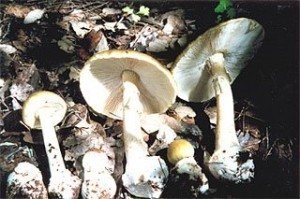Death Cap Mushroom Sizes
Known scientifically as Amanita phalloides, the death cap is a basidiomycete fungus that is considered poisonous. It is widely found in Europe, which belongs to the genus Amanita. It is closely associated with different kinds of deciduous trees as well as different kinds of pines, chestnuts and oaks. This mushroom usually has a cap with relatively greenish color, while its gills and stipe are white. Aside from these interesting details, there are more to learn about this toxic species including the different death cap mushroom sizes.
basidiomycete fungus that is considered poisonous. It is widely found in Europe, which belongs to the genus Amanita. It is closely associated with different kinds of deciduous trees as well as different kinds of pines, chestnuts and oaks. This mushroom usually has a cap with relatively greenish color, while its gills and stipe are white. Aside from these interesting details, there are more to learn about this toxic species including the different death cap mushroom sizes.
The Sizes of Death Cap Mushrooms
The pileus or cap of the death cap measures approximately 2 to 6 inches or 5 to 15 centimeters. The length of its stipe or stem ranges from 3 to 6 inches or 8 to 15 centimeters, while the thickness is measured at 0.39 to 0.79 inch or 1 to 2 centimeters. It also features transparent spores, each of which has a length of approximately 0.3 to 0.4 mil or 8 to 10 micrometers.
Additional Facts and Other Interesting Details
The fruiting body of the death cap is described as imposing and large. It has a hemispherical and rounded pileus or cap, which eventually flattens as it ages. The cap appears in various colors including olive-greenish, yellowish and pale. The surface of the cap becomes sticky, particularly when wet. It features a white stipe with scattering scales that are grayish-olive in color. The volva or base is commonly sac-like white, ragged and swollen.
In terms of odor, the death cap is somewhat honey-sweet and faint. However, it strengthens over time and changes to something objectionable, sickly-sweet and overpowering. One of the common features of the genus Amanita is the whitish spore print. The gills are said to contain concentrated levels of sulfuric acid.
This highly toxic fungus has already caused a number of fatal mushroom poisonings all over the world. Based on research, approximately an ounce or 30 grams of it is sufficient to kill a human being. Different kinds of processes such as drying, freezing or cooking cannot reduce the toxicity of this specific kind of mushroom.
Death caps are dangerous because they have a pleasant taste, which makes it hard to differentiate from edible mushroom varieties. Furthermore, the symptoms of poisoning are somewhat delayed. Some of the common gastrointestinal symptoms are vomiting, watery diarrhea and abdominal pain.
In worse cases, patients may exhibit severe signs such as hypoglycemia, tachycardia and hypotension. Its complications are described as life threatening, which may include cardiac arrest, acute renal failure and pancreatitis. In addition, there is also a strong possibility for patients to develop intracranial hemorrhage and enhanced intracranial pressure.




